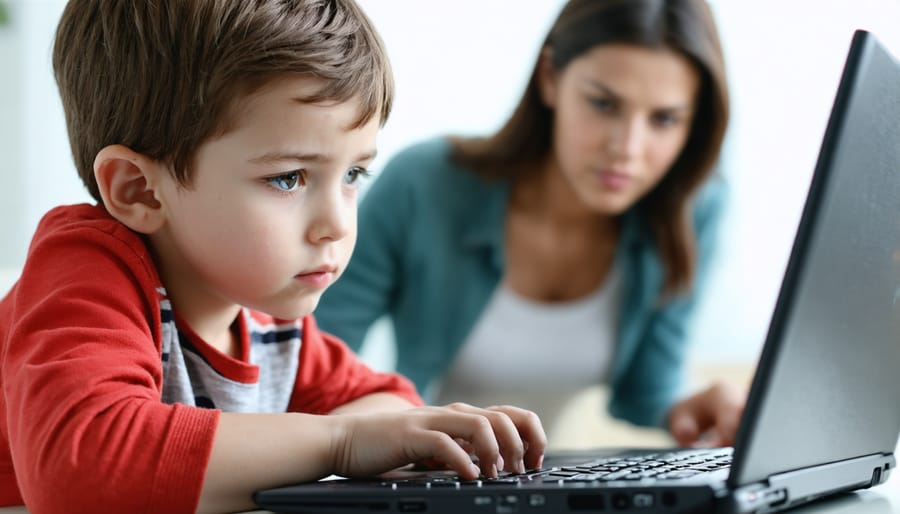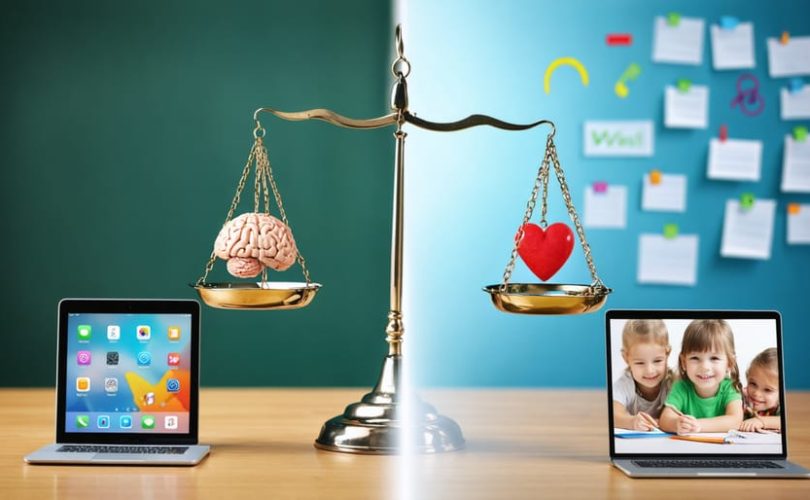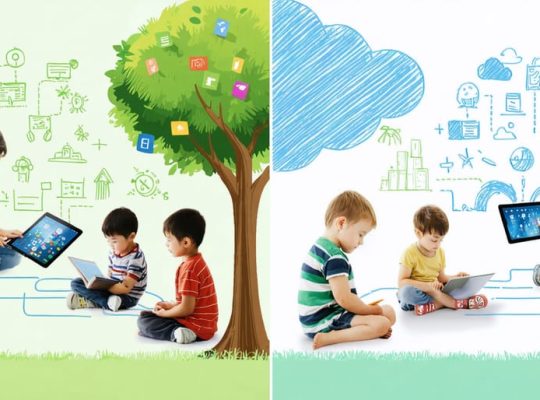In today’s hyperconnected classrooms, digital learning’s impact on mental well-being reaches far beyond academic performance. As parents and educators, we’re witnessing an unprecedented transformation in how children learn, interact, and process information. This shift brings both remarkable opportunities and significant challenges for our children’s mental health.
The intersection of technology and learning has created a new landscape where screen time, social interactions, and cognitive development intertwine in complex ways. Research shows that while digital tools can enhance learning engagement, they also influence attention spans, emotional regulation, and social skill development. Understanding this delicate balance becomes crucial as we guide our children through their educational journey.
Our responsibility extends beyond merely monitoring device usage—we must actively shape healthy digital learning environments that support both academic growth and emotional wellness. By recognizing early warning signs of digital stress and implementing balanced approaches to technology use, we can help our children thrive in this digital age while preserving their mental health foundation.
The good news? Small, intentional changes in how we approach digital learning can make a significant difference in protecting and promoting our children’s mental well-being. Let’s explore practical strategies that work for both classroom and home settings.
The Digital Learning Landscape Today

Screen Time vs. Learning Time
In today’s digital age, it’s crucial to differentiate between productive learning time and passive screen consumption. While educational apps and online resources can enhance learning, excessive screen time can impact mental well-being and cognitive development.
Dr. Sarah Chen, a child development specialist, suggests following the 20-20-20 rule: after 20 minutes of screen time, look at something 20 feet away for 20 seconds. This helps reduce eye strain and maintains focus. Additionally, scheduling dedicated “tech-free” learning periods can help children develop traditional learning skills and creativity.
Consider these balanced approaches:
– Alternate between digital and hands-on learning activities
– Set clear boundaries between entertainment and educational screen time
– Use screen time tracking tools to monitor daily usage
– Encourage active learning engagement rather than passive consumption
Remember that quality matters more than quantity. A 30-minute interactive educational session can be more valuable than hours of unfocused screen time. Look for signs that screen time might be affecting your child’s learning, such as decreased attention span, irritability when disconnecting, or difficulty engaging with non-digital activities.
Common Digital Learning Platforms
Popular digital learning platforms like Google Classroom, Canvas, and Kahoot have become integral parts of modern education. When designed thoughtfully, these platforms can support students’ mental well-being while facilitating learning. The best platforms incorporate features like progress tracking, customizable learning paths, and positive reinforcement systems that help students feel accomplished and motivated.
Many successful platforms use color psychology and intuitive interfaces to reduce cognitive load and anxiety. For example, Duolingo’s friendly mascot and bite-sized lessons make learning less intimidating, while ClassDojo’s emphasis on positive behavior reinforcement helps build student confidence.
However, it’s essential to consider potential stress triggers in these platforms. Timer features, public performance displays, and complex navigation can increase anxiety for some students. Educational technology companies are increasingly working with mental health professionals to create more supportive learning environments.
As Sarah Chen, an educational psychologist, notes, “The best digital learning platforms balance academic achievement with emotional well-being, providing options for students to learn at their own pace and receive encouragement along the way.”
Mental Health Challenges in Digital Learning
Social Isolation and Online Learning
The shift to online learning during recent years has highlighted the significant impact of social isolation on students’ mental well-being. Children and teenagers, who typically thrive on face-to-face interactions with peers, have found themselves navigating a very different social landscape through screens and digital platforms.
Many parents have observed changes in their children’s behavior during periods of online learning, including increased feelings of loneliness, anxiety, and disconnection from their school community. Sarah Chen, a child psychologist, notes, “The casual interactions that happen in hallways, during lunch breaks, or on the playground are crucial for social development and emotional well-being. These moments can’t be fully replicated in a virtual environment.”
However, there are effective ways to help students maintain social connections while learning remotely. Creating structured virtual social time, organizing small outdoor meetups when possible, and encouraging participation in online group activities can help bridge the social gap. Many schools have implemented “virtual buddy systems” and social hours to ensure students stay connected with their classmates.
Parents can also support their children by helping them establish regular video chat schedules with friends, participating in online group projects, and finding creative ways to celebrate milestones and special occasions virtually. Remember, while online interactions may not perfectly replace in-person connections, they can still provide valuable social support during periods of distance learning.
Digital Anxiety and Stress
In today’s digital learning environment, students face unique mental health challenges that weren’t present just a generation ago. Many children experience what experts call “digital anxiety” – a form of stress directly related to technology use in educational settings.
Sarah Thompson, a school counselor with 15 years of experience, notes: “I’ve seen a significant increase in students feeling overwhelmed by constant connectivity and digital expectations. It’s not just about screen time; it’s about the pressure to always be ‘on’ and responsive.”
Common signs of digital anxiety include difficulty concentrating during online lessons, feeling overwhelmed by digital assignments, and experiencing physical symptoms like headaches or eye strain. Students might also feel anxious about technical difficulties or comparing their digital abilities to peers.
Parents and educators can help manage digital stress by:
– Establishing regular “tech breaks” during study sessions
– Creating designated offline learning periods
– Teaching healthy boundaries with educational technology
– Implementing relaxation techniques between digital tasks
– Maintaining open communication about technology-related concerns
Remember that each child responds differently to digital learning environments. Some may thrive with technology, while others need more support and alternative learning methods. The key is finding the right balance that works for your child or student.
“It’s essential to normalize conversations about digital stress,” explains Dr. Maria Chen, child psychologist. “When we acknowledge these feelings, we can better support our children in developing healthy coping strategies.”

Creating a Mentally Healthy Digital Learning Environment
Setting Healthy Boundaries
In today’s digital age, establishing healthy boundaries around online learning is crucial for maintaining mental well-being. As Sarah Thompson, a child psychologist with 15 years of experience, notes, “Children need a balanced approach that combines digital engagement with real-world experiences.”
Start by creating designated “tech zones” in your home where learning devices are used, keeping bedrooms as screen-free spaces. Set specific time blocks for online learning, incorporating regular breaks using the 20-20-20 rule: every 20 minutes, take a 20-second break and look at something 20 feet away to reduce eye strain and mental fatigue.
Implement a digital sunset routine where all devices are turned off at least one hour before bedtime. This helps maintain healthy sleep patterns and allows the brain to wind down naturally. Consider using screen time tracking apps to monitor and manage digital learning hours effectively.
Balance online activities with offline engagement through:
– Physical exercise and outdoor play
– Face-to-face social interactions
– Creative activities like drawing or crafting
– Reading physical books
– Mindfulness practices or quiet reflection time
Create a family media agreement that outlines clear expectations for device usage, including consequences and rewards. Regular “tech-free” periods during meals and family activities help maintain meaningful connections and provide necessary mental breaks.
Remember that boundaries aren’t about restriction but rather creating a healthy relationship with technology. As children develop better self-regulation skills, gradually adjust these boundaries to match their growing independence and responsibility levels.

Supporting Emotional Well-being
Digital learning can sometimes feel isolating, but there are many effective ways of supporting emotional health while learning online. Creating a balanced routine is essential – start by establishing regular breaks between study sessions, incorporating physical movement, and maintaining consistent sleep schedules.
Dr. Sarah Chen, a child psychologist, suggests, “Think of emotional well-being like a garden that needs daily tending. Regular check-ins, mindfulness exercises, and social connections are the water and sunlight our children need to thrive in digital spaces.”
Consider implementing these practical strategies:
– Create a dedicated learning space that’s comfortable and well-lit
– Schedule virtual study groups or social interaction time with classmates
– Practice deep breathing exercises between lessons
– Use mood tracking apps or journals to monitor emotional responses
– Celebrate small achievements and progress regularly
“When my daughter started feeling overwhelmed with online classes, we introduced ’emotion check-ins’ twice a day,” shares Maria, a mother of two. “This simple practice helped her become more aware of her feelings and better at expressing when she needed support.”
Remember to watch for signs of digital fatigue or stress, such as irritability, headaches, or changes in sleep patterns. Encourage open conversations about feelings and challenges, and don’t hesitate to reach out to teachers or counselors when additional support is needed. Building emotional resilience takes time, but with consistent care and attention, children can develop healthy coping mechanisms while mastering digital learning.
Signs Your Child Needs Support
Behavioral Changes to Watch For
As children spend more time learning digitally, certain behavioral changes may signal that they’re experiencing stress or struggling to adapt. Watch for sudden shifts in sleep patterns, such as difficulty falling asleep or sleeping too much. Changes in eating habits, either loss of appetite or stress eating, can also be telling indicators.
Pay attention if your child becomes increasingly irritable, withdrawn, or shows resistance to online learning activities they previously enjoyed. Some children might express physical complaints like headaches or stomach aches when it’s time for digital learning sessions.
Another crucial area to monitor is your child’s social development and interaction patterns. If they’re showing less interest in connecting with friends, even virtually, or becoming more isolated, this could indicate emotional challenges.
Other warning signs include:
– Unusual difficulty concentrating or completing tasks
– Increased anxiety about academic performance
– Emotional outbursts during or after online sessions
– Excessive screen time beyond learning requirements
– Loss of interest in previously enjoyed offline activities
Remember, occasional changes are normal as children adjust to digital learning environments. However, if these behaviors persist or significantly impact daily life, it’s important to address them promptly and seek professional guidance when needed.
When to Seek Professional Help
While many learning-related mental health challenges can be addressed through preventive measures and basic support, certain situations warrant professional intervention. As Dr. Sarah Chen, a child psychologist, notes, “Early intervention can make a significant difference in a child’s educational journey and overall well-being.”
Watch for persistent signs that last more than two weeks, such as:
– Sudden changes in academic performance
– Withdrawal from friends and activities
– Excessive worry about schoolwork
– Difficulty sleeping or eating
– Expressing feelings of hopelessness
– Regular complaints about physical symptoms (headaches, stomach aches)
– Aggressive behavior or intense emotional outbursts
Seek immediate help if your child:
– Expresses thoughts of self-harm
– Shows severe anxiety about attending school
– Demonstrates significant personality changes
– Exhibits extreme mood swings
– Completely refuses to participate in learning activities
Remember, reaching out for help is a sign of strength, not weakness. Start by consulting your child’s teacher or school counselor, who can often provide valuable insights and initial support. They may recommend further evaluation by a mental health professional who specializes in educational challenges.
Many parents report that getting professional help early helped prevent more serious issues from developing. As one parent shared, “We noticed our daughter becoming increasingly anxious about online classes. Speaking with a counselor helped us develop strategies that made a real difference.”
Supporting your child’s mental health while navigating the digital learning landscape may feel overwhelming, but remember that small, consistent steps can make a significant difference. Throughout this article, we’ve explored how digital learning impacts mental health and discovered practical strategies to create a balanced, healthy approach to education in the digital age.
Remember that every child is unique, and what works for one may not work for another. The key is to remain observant, maintain open communication, and be willing to adjust your approach as needed. By implementing the strategies we’ve discussed – from establishing healthy screen time boundaries to creating dedicated offline learning spaces and incorporating physical activity – you’re already taking important steps toward protecting your child’s mental well-being.
Don’t hesitate to reach out for professional help if you notice persistent signs of stress, anxiety, or other mental health concerns in your child. Many schools and healthcare providers now offer specialized support for families navigating these challenges.
Most importantly, be gentle with yourself and your child during this journey. Progress isn’t always linear, and it’s okay to have difficult days. By staying informed, responsive, and supportive, you’re helping your child develop the resilience and coping skills they’ll need for a lifetime of healthy learning and growth. Remember, you’re not alone in this journey – there’s a whole community of parents, educators, and professionals working together to support children’s mental health in the digital age.




